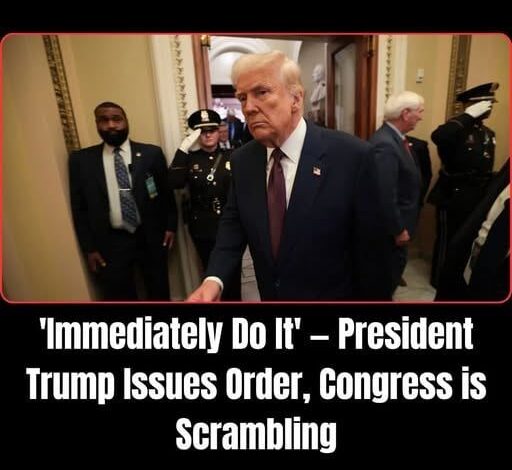Trump Just Dropped a Bombshell Inside the Senate, Do it now, or! See more

Washington was on edge as the Senate reconvened for its 37th consecutive day of the longest government shutdown in U.S. history. The Capitol’s marble halls buzzed with frustration, exhaustion, and political tension. At the center of it all stood Donald Trump, now a former president but still very much a political force, urging Senate Republicans to do something drastic — to eliminate the filibuster entirely.
Behind closed doors, conversations had grown heated. Senate Majority Leader John Thune was reportedly negotiating with Democrats on a short-term funding deal that would keep parts of the government running until the following January. But under the current rules, any such bill would need 60 votes to pass — a near-impossible feat in an evenly divided Senate. Trump, however, was having none of it.
“It’s time to end the filibuster and get everyone back to work,” he declared from the Oval Office. “Pass voter ID, stop mail-in voting except for the military, one-day voting, secure the borders, fix immigration — we could do it all ourselves.”
For Trump, the moment wasn’t just about reopening the government. It was about seizing what he saw as a rare opportunity to reshape the system itself. He viewed the filibuster — the procedural rule requiring a supermajority for most major legislation — as an outdated obstacle that allowed “career politicians” to hide behind process instead of producing results.
That morning, he’d hosted a tense breakfast meeting with several key Republican senators. According to multiple accounts, what began as a policy discussion quickly turned into a verbal brawl. Lindsey Graham, one of Trump’s longtime allies, reportedly tried to caution him. But Trump cut him off. “Lindsey, you and I both know reconciliation only gets you so far,” he said sharply. “We’re supposed to be the party of action — not excuses. If we keep playing by their rules, we’ll die by them.”
He wasn’t bluffing. Those in the room said Trump’s tone was part warning, part ultimatum. “The GOP is becoming a dead party,” he said. “Do it now, or lose everything later.”
Outside the White House, the government shutdown had entered its sixth week. Federal workers were missing paychecks. Airports were facing staff shortages. The public was growing restless. And while Democrats blamed Trump’s influence for hardening Republican resistance, Trump’s supporters insisted he was the only one willing to do what others wouldn’t — push Washington to the breaking point in the name of change.
Meanwhile, Majority Leader Thune tried to steady the Senate’s course. Publicly, he defended the filibuster as a necessary “guardrail” against chaos, reminding reporters that both parties had once relied on it to protect minority interests. “The day we get rid of the filibuster,” Thune said, “is the day the Senate stops being the Senate.”
But privately, even some of Thune’s allies admitted the rule had become a political weapon. Over the past decade, both parties had used it to stall progress — on immigration, on voting rights, on budget reform. Every administration, Republican or Democrat, had complained about it. None had dared to kill it outright.
Democrats, for their part, were split. Some favored cutting a deal — a temporary funding package that would reopen the government while guaranteeing a later vote on healthcare subsidies and infrastructure spending. Others warned that bending too far would only encourage Trump to double down. “He’s testing the limits,” one Democratic aide said. “If we cave now, there won’t be any limits left.”
Still, the pressure was mounting. Polls showed that Americans overwhelmingly wanted the government reopened, and both sides risked political damage. But Trump’s strategy, as always, was high-stakes. He was betting that the longer the standoff dragged on, the more desperate Congress would become — and the more leverage he would gain.
From his office, Trump’s message grew more forceful by the hour. “End it now,” he told a room of aides. “Or we’ll never fix America.”
He also issued a stark warning to Republicans who hesitated: “If you think this is bad, wait until Democrats run everything. They’ll make D.C. and Puerto Rico states. They’ll pack the Supreme Court. They’ll rewrite every law we ever passed. You stop them by changing the rules — now.”
The comment quickly made its way around Washington, sparking outrage and panic in equal measure. For Trump’s base, it was classic hardball politics — a necessary wake-up call. For his critics, it was a dangerous threat to democratic norms.
As the hours dragged on, reporters camped outside the Capitol, waiting for any sign of progress. Inside, tempers flared. Some senators demanded an immediate vote to reopen key agencies. Others argued that caving to Trump’s demands would destroy the Senate’s integrity. Staffers whispered in the corridors about the growing rift inside the Republican caucus — a party pulled between pragmatism and loyalty.
By nightfall, the Senate chamber felt less like a legislative body and more like a battlefield. Thune, visibly weary, stood at the podium, calling for calm. Across the aisle, Democrats watched in silence as Republicans debated their own future.
For all the noise, no one knew how it would end. But everyone knew this much — Trump had shifted the ground beneath Washington once again. His push to end the filibuster wasn’t just about a shutdown. It was about power — who held it, who could use it, and who would dare to change the rules to keep it.
The next morning, as headlines blared TRUMP DEMANDS END TO FILIBUSTER and SENATE ON BRINK, one veteran lawmaker summed it up grimly: “This isn’t about procedure anymore. It’s about survival.”
Whether the confrontation would break the deadlock or plunge the capital into deeper chaos was anyone’s guess. But one thing had become undeniable — for better or worse, Donald Trump still knew how to make Washington tremble.